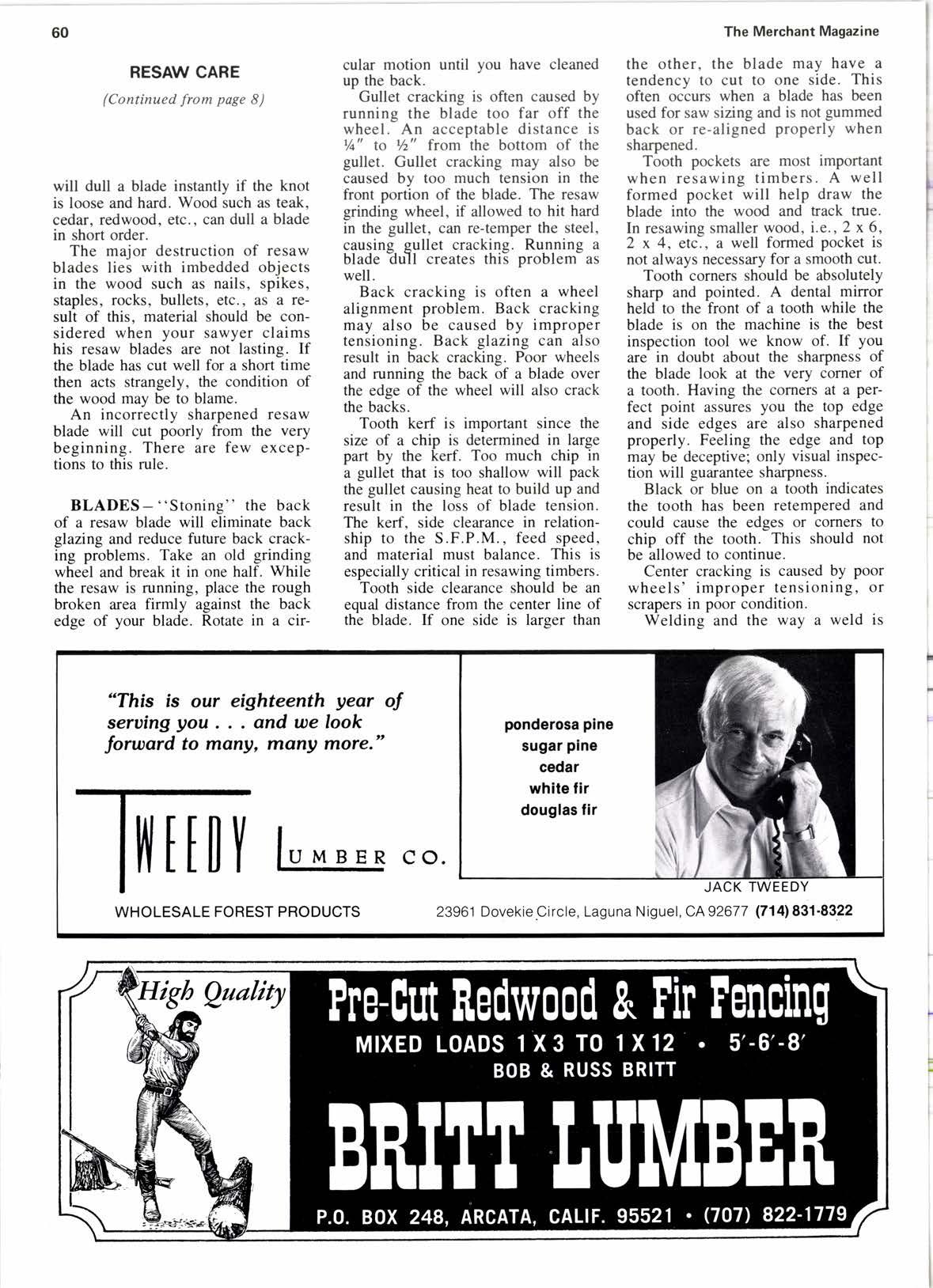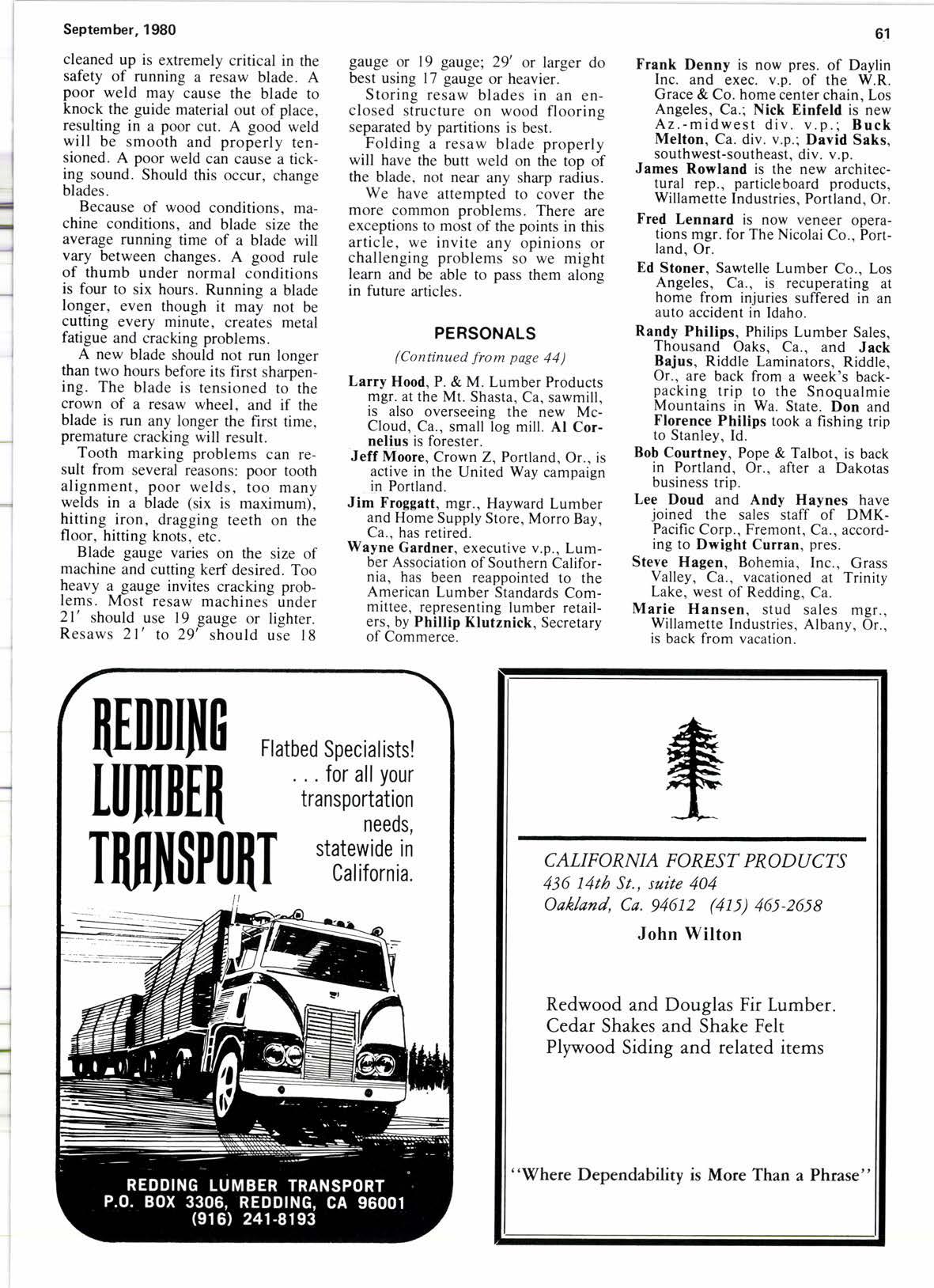
5 minute read
RESAW CARE
(Continued from page 8) will dull a blade instantly if the knot is loose and hard. Wood such as teak, cedar, redwood, etc., can dull a blade in short order.
The major destruction of resaw blades lies with imbedded objects in the wood such as nails, spikes, staples, rocks, bullets, etc., as a result of this, material should be considered when your sawyer claims his resaw blades are not lasting. If the blade has cut well for a short time then acts strangely, the condition of the wood may be to blame.
An incorrectly sharpened resaw blade will cut poorly from the very beginning. There are few exceptions to this rule.
BLADES- "Stoning" the back of a resaw blade will eliminate back glazing and reduce future back cracking problems. Take an old grinding wheel and break it in one half. While the resaw is running, place the rough broken area firmly against the back edge of your blade. Rotate in a cir- cular motion until you have cleaned up the back.
Gullet cracking is often caused by running the blade too far off the wheel.-An acceptable distance is Vc" to Vz" from the bottom of the gullet. Gullet cracking may also be caused by too much tension in the front portion of the blade. The resaw grinding wheel, if allowed to hit hard in the gullet, can re-temper the steel, causins eullet crackins. Running a blade tu'll creates thiS problern-as well.
Back cracking is often a wheel alignment problem. Back cracking may also be caused by improper tensioning. Back glazing can also result in back cracking. Poor wheels and running the back of a blade over the edge of the wheel will also crack the backs.
Tooth kerf is important since the size of a chip is determined in large part by the kerf. Too much chip in a gullet that is too shallow will pack the gullet causing heat to build up and result in the loss of blade tension. The kerf, side clearance in relationship to the S.F.P.M., feed speed, and material must balance. This is especially critical in resawing timbers.
Tooth side clearance should be an equal distance from the center line of the blade. If one side is larger than the other, the blade may have a tendency to cut to one side. This often occurs when a blade has been used for saw sizing and is not gummed back or re-aligned properly when sharpened.
Tooth pockets are most important when resawing timbers. A well formed pocket will help draw the blade into the wood and Eack true. In resawing smaller wood, i.e., 2 x 6, 2 x 4, etcl, a well formed pocket is not always necessary for a smooth cut.
Tooth corners should be absolutely sharp and pointed. A dental mirror held to the front of a tooth while the blade is on the machine is the best inspection tool we know of. If you are in doubt about the sharpness of the blade look at the very corner of a tooth. Having the comers at a perfect point assures you the top edge and side edges are also sharpened properly. Feeling the edge and top may be deceptive; only visual inspection will guarantee sharpness.
Black or blue on a tooth indicates the tooth has been retempered and could cause the edges or corners to chip off the tooth. This should not be allowed to continue.
Center cracking is caused by poor wheels' improper tensioning, or scrapers in poor condition.
Welding and the way a weld is cleaned up is extremely critical in the safety of running a resaw blade. A poor weld may cause the blade to knock the guide material out of place, resulting in a poor cut. A good weld will be- smocith and proferly rensioned. A poor weld can cause a ticking sound. Should this occur, change blades.
Because of wood conditions, machine conditions, and blade size the average running time of a blade will vary between changes. A good rule of thumb under normal conditions is four to six hours. Runnine a blade longer, even though it ma! not be cutting every minute, creates metal fatigue and cracking problems.
A new blade should not run lonser than two hours before its first sharp6n- ing. The blade is tensioned to- the crown of a resaw wheel, and if the blade is run any longer the first time, premature cracking will result.
Tooth marking problems can result from several reasons: poor tooth alignment, poor welds, too many welds in a blade (six is maximum), hitting iron. dragging teeth on the floor, hitting knots, etc.
Blade gauge varies on the size of machine and cutting kerf desired. Too heavy a sause invites crackins oroblems-. M-ost-resaw machines- dnder 2l' should use 19 gauge or lighter. Resaws 2l' to 29'- shiuld uie t g gauge or 19 gauge; 29' or larger do best using 17 gauge or heavier.
Storing resaw blades in an enclosed structure on wood floorine separated by partitions is best. Folding a resaw blade properly will have the butt weld on the top of the blade, not near any sharp radius. We have attempted to cover the more common problems. There are exceptions to most of the points in this article, we invite any opinions or challenging problems- so^we might learn and be able to pass them along in future articles.
Personals
(Continued from page 44)
Larry Hood, P. & M. Lumber Products mgr. at the Mt. Shasta, Ca, sawmill, is also overseeing the new McCloud, Ca., small log mill. Al Cornelius is fqrester.
Jeff Moore. Crown Z. Portland. Or.. is active in the United Way campaign in Portland.
Jim Froggatt, Dgr., Hayward Lumber and Home Supply Store, Morro Bay, Ca., has retired.
Wayne Gardner, executive v.p., Lumber Association of Southern California, has been reappointed to the American Lumber Standards Committee, representing lumber retailers, by Phillip Klutznick, Secretary of Commerce.
Frank Denny is now pres. of Daylin Inc. and exec. v.p. of the W.R. Grace & Co. home center chain. Los Angeles, Ca.; Nick Einfeld is new Az.-midwest div. v.p.; Buck Melton, Ca. div. v.p.; David Saks, southwest-southeast, div. v.p.
James Rowland is the new architectural rep., particleboard products, Willamette Industries. Portland. Or.
Fred Lennard is now veneer operations mgr. for The Nicolai Co., Portland, Or.
Ed Stoner, Sawtelle Lumber Co., Los Angeles, Ca., is recuperating at home from injuries suffered in an auto accident in ldaho.

Randy Philips, Philips Lumber Sales, Thousand Oaks, Ca., and Jack Bajus, Riddle Laminators, Riddle, Or., are back from a week's backpacking trip to the Snoqualmie Mountains in Wa. State. Don and Florence Philips took a fishing trip to Stanley, Id.
Bob Courtney, Pope & Talbot, is back in Portland, Or., after a Dakotas business trip.
Lee Doud and Andy Haynes have joined the sales staff of DMKPacific Corp., Fremont, Ca., according to Dwight Curran, pres. Steve Hagen, Bohemia, Inc., Grass Valley, Ca., vacationed at Trinity Lake, west of Redding, Ca.
Marie Hansen, stud sales mgr., Willamette Industries, Albany, Or., is back from vacation.
CALIFORNIA FOREST PRODUCTS
436 14tb St., saite 404
Oakland, Ca. 94612 (415) 465-2655
John Wilton
Redwood and Douglas Fir Lumber. Cedar Shakes and Shake Felt
Plywood Siding and related items
"Where Dependability is More Than a Phrase"










